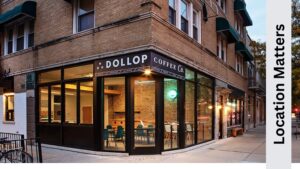Dreaming of owning a cozy café that’s always buzzing with coffee lovers and friends sharing stories over artisanal pastries? Starting a café is an exciting journey that lets you create a unique space where coffee culture, community, and quality blend seamlessly. But to brew up a successful café, there’s much to consider—everything from planning and budgeting to sourcing coffee beans and designing a customer-friendly ambiance.
This guide will walk you through every step of opening a café, covering essential aspects like crafting a business plan, finding the perfect café location, curating a standout menu, and building a loyal customer base. We’ll dive into the details of café setup, from selecting the right espresso machines to designing an inviting café layout, and we’ll look at key strategies like effective marketing and customer loyalty programs to ensure long-term growth. Whether you’re looking to start a café on a budget or offer a high-end, eco-friendly experience, these tips will help you turn your dream into a thriving business.
Let’s get started on creating a café that goes beyond serving coffee—one that offers a memorable customer experience connects with the community, and keeps people coming back for more.
How to Start A Cafe: Everything You Need to Know to Start Brewing Success
Dreaming of owning a cozy café where people gather to enjoy great coffee and conversation? This guide covers everything you need to start your own café, from choosing the perfect location to curating a menu that delights. Get ready to brew success with practical tips on planning, budgeting, and attracting loyal customers!
Research and Planning: Laying the Foundation for Success
Starting a café begins with thorough planning and research, as these steps lay the groundwork for a sustainable business.
Define Your Vision and Goals
First, it’s essential to establish a clear vision and define your goals for the café. Consider the type of atmosphere and experience you want to offer—perhaps a cozy, artisanal café with a focus on local sourcing and seasonal menus or a vibrant spot designed to draw a bustling morning crowd with fast service and customizable drink options. Defining your café’s unique brand identity will guide every subsequent decision, from the coffee you serve to the décor you choose. Also, don’t forget to find out a suitable name for your brewing cafe.
Conduct Market Research and Competitor Analysis
Conducting a thorough target market analysis is crucial. Who are the ideal customers in your location? Are they young professionals looking for a quick, quality espresso on their way to work, or do they prefer a relaxed environment where they can linger over pastries and free Wi-Fi? Researching the local café competitors can also provide valuable insights. Look at what’s working in the area, what’s missing, and how your café can offer something unique. For example, if local cafés lack outdoor seating or eco-friendly packaging options, these could be features to distinguish your business.

Budgeting and Financing
A detailed business plan is your next critical step. This document will help you outline your initial budget, financing needs, and estimated operational costs. Think about the essentials, such as sourcing quality coffee beans and equipment, hiring staff, and marketing. A clear budget and financial plan also help you understand if you’ll need a business loan or investors to get started. Planning for profitability involves calculating expenses like rent, utilities, inventory, and staff salaries to ensure a financially sustainable café.
Choosing the Right Location
Location plays a pivotal role in your café’s success. Choosing a spot with high foot traffic, like near office buildings, shopping centers, or universities, can significantly increase visibility and draw in potential customers. When scouting for an ideal café location, consider factors like accessibility, parking, and visibility. A lease agreement will be essential, so work with a reliable realtor or legal advisor to negotiate terms that align with your budget and business goals.

Evaluating the physical space is equally important. Think about how the layout can enhance customer flow and create a comfortable seating arrangement. For example, a small café may benefit from a minimalistic design that maximizes seating without feeling crowded, while a larger space might have room for cozy corners, communal tables, and even outdoor seating. Design choices like lighting, color scheme, and décor can establish the café ambiance and influence customer experience. For instance, warm lighting and rustic wooden furniture can create a welcoming, cozy atmosphere that encourages customers to stay longer.
Selecting an accessible location can also open up additional revenue streams. Being in a central spot may allow for takeaway service, delivery options, or hosting events, expanding your reach beyond just in-store customers. Remember that the right location can shape the long-term success of your café, attracting a steady customer base and positioning your brand as a staple in the community.
Setting Up Your Café: Equipment and Décor
Once you’ve secured a location, it’s time to focus on setting up your café with the right equipment and a captivating design.
Quality coffee-making equipment is at the heart of any successful café, so invest in essentials like high-grade espresso machines, grinders, and brewing equipment. These items may require a significant upfront cost, but they are integral to delivering consistent, high-quality coffee that meets customer expectations. Additionally, a modern and efficient POS system is essential for smooth transactions and inventory management, ensuring a seamless experience for customers and staff alike.
Design plays a big role in defining your café’s identity and creating an ambiance that resonates with customers. Think about your target audience and the type of space they’d be drawn to. For instance, young professionals might prefer a minimalist aesthetic with ample natural light and quiet areas for working, while families might be drawn to a warm, inviting setting with comfortable seating. Incorporating a few eco-friendly elements, like sustainable materials and energy-efficient lighting, can appeal to environmentally conscious customers and enhance your brand’s appeal.
A standout café layout balances function and comfort, allowing staff to move efficiently while customers enjoy their space. Consider investing in small touches that improve the customer experience, like comfortable seating, unique artwork, or a well-organized counter display featuring pastries and menu items. Offering free Wi-Fi and convenient charging stations can also attract remote workers and students, encouraging them to spend more time (and money) in your café. By creating a comfortable and aesthetically pleasing environment, you’ll set the stage for a café that customers will remember and want to return to.
Curating a Winning Café Menu

Creating a unique menu is essential for making your café stand out and ensuring a memorable customer experience. Your menu should reflect your café’s brand identity and resonate with the tastes of your target market.
Begin by focusing on a range of quality coffee options, as coffee is the cornerstone of most cafés. Offering a selection of roasts and brewing methods—such as espresso, pour-over, cold brew, and French press—can attract coffee enthusiasts looking for variety and specialty options. Partnering with local coffee roasters can add an artisanal touch and support sustainable sourcing practices, enhancing the quality and appeal of your offerings.
In addition to coffee, consider adding a range of complementary items like teas, smoothies, and non-coffee drinks to accommodate diverse tastes and dietary preferences. Creating a seasonal menu can also keep customers interested and provide an opportunity to showcase unique items, such as pumpkin lattes in the fall or iced fruity teas in the summer.
Including fresh pastries, sandwiches, or light breakfast and lunch options can increase revenue by encouraging customers to spend more during each visit. Locally sourcing ingredients for these items can emphasize freshness and quality while also fostering community connections.
Beyond the basics, think about how to make your menu accessible and engaging. Offering customizable drink options—such as alternative milk, sugar-free syrups, and extra espresso shots—gives customers more control over their order, which can elevate satisfaction and make them feel valued. Clearly displaying prices and creating an aesthetically pleasing, easy-to-read menu also enhances the customer experience.
Offering a variety of serving sizes or sharing options can cater to groups or those looking for a quick, affordable coffee break, expanding your appeal across different customer demographics. A thoughtfully curated menu can be a powerful tool for driving revenue, creating brand loyalty, and setting your café apart from competitors.
Staffing and Training: Building a Strong Café Team

The quality of service in your café is as important as the quality of your coffee. Hiring and training the right staff is essential to deliver a consistently positive customer experience and establish a reputation for friendly, professional service. When hiring baristas and support staff, look for qualities such as a passion for coffee, good communication skills, and a friendly attitude. Experienced baristas can bring valuable skills to the table, but hiring enthusiastic individuals who are eager to learn can also work if you provide proper training.
Training should go beyond basic coffee-making techniques to include customer service skills, upselling techniques, and knowledge about the items on your menu. Offering a comprehensive barista training program ensures your staff can make high-quality drinks while maintaining efficiency during peak hours. They should also be able to answer questions about different coffee beans, brewing methods, and drink options.
Cross-training employees in different areas, such as cashier duties and basic maintenance of coffee equipment, can improve team flexibility and help the café run smoothly even when short-staffed.
Establishing a positive work environment is also key to retaining a strong team. Happy, motivated staff are more likely to create a welcoming atmosphere for customers, contributing to a pleasant customer experience that encourages loyalty and repeat visits. Encourage open communication and provide constructive feedback to help staff develop their skills. Implementing incentives like performance bonuses or offering perks like free coffee can help motivate employees and make them feel valued.
Ultimately, a well-trained and motivated team is an asset that not only enhances your café’s reputation but also ensures smooth daily operations, contributing to the overall success of your business.
Marketing and Branding: Attracting and Retaining Customers
Marketing plays a critical role in building awareness, attracting customers, and establishing a loyal customer base for your café. Start by developing a strong café brand that reflects your unique identity and values.
Your branding should be consistent across all channels, from the logo and color scheme to the tone of your social media posts. A clear and appealing brand identity helps customers connect with your café on an emotional level, which can be a powerful factor in building loyalty.
Social media is one of the most effective tools for promoting your café and engaging with customers. Platforms like Instagram and Facebook allow you to share visually appealing photos of your coffee, food, and café ambiance. Engaging content, such as behind-the-scenes stories, customer spotlights, and user-generated content, can create a sense of community and encourage followers to visit your café.
Regularly posting updates, promotions, and seasonal menu items can keep your café top-of-mind for customers. Collaborating with local influencers or hosting events can also help increase your café’s visibility and attract new customers from within the community.
Implementing a loyalty program is another effective strategy to retain customers and increase the frequency of their visits. Consider offering rewards such as a free drink after a certain number of purchases or discounts on special occasions like birthdays. Loyalty programs incentivize repeat visits and can be a key driver of long-term customer retention. You could also gather customer feedback through surveys or comment cards to understand their preferences and continually improve the café experience.
Local marketing efforts, such as hosting events or participating in community activities, can further enhance your café’s presence. Partnering with local businesses for joint promotions, sponsoring small events, or donating to local causes can build goodwill and connect your café to the community in meaningful ways. Creating a friendly, welcoming environment with personalized customer service will help you turn first-time visitors into loyal customers, ultimately driving the growth and success of your café.
Financial Planning and Budgeting: Preparing for Long-Term Stability

Creating a comprehensive financial plan is essential for the long-term success of your café.
Begin by determining your initial startup costs, including expenses like lease deposits, renovations, equipment, furniture, and initial inventory. Estimating these startup costs accurately allows you to understand your funding needs and prepare for additional, often unforeseen, expenses. Costs such as insurance, permits, and licensing fees can vary depending on your location and specific café concept.
Once you’ve calculated startup costs, focus on setting up a reliable cash flow forecast to manage day-to-day finances. A financial forecast helps you anticipate monthly expenses, including rent, utilities, salaries, and ingredient costs, so you can allocate resources effectively.
Tracking these expenses regularly can also help you adjust pricing, menu items, or operational hours if necessary to maintain profitability. It’s important to set revenue goals that account for profit margins, which can vary depending on factors like menu pricing, cost of goods sold, and customer volume.
Securing funding for your café may involve seeking loans, personal savings, or investors. For those looking to raise capital, presenting a well-documented business plan to potential investors can enhance your credibility and demonstrate your understanding of the industry. To ensure financial stability, consider setting up an emergency fund to cover unexpected expenses, such as equipment repairs or seasonal fluctuations in customer traffic.
A sound financial plan enables you to weather challenges and maintain profitability, ensuring your café thrives over time.
Navigating Legal Requirements and Permits: Ensuring Compliance
Opening a café requires adherence to specific legal requirements and permits to operate smoothly and avoid penalties. Familiarize yourself with the business licenses, health permits, and food safety certifications necessary in your area, as these can vary by region. For instance, food handling and preparation regulations are crucial for ensuring your café meets local health department standards. Failure to comply with these regulations can result in fines or temporary closure, so it’s vital to stay informed and up-to-date.
In addition to health permits, a business license is typically required to operate a café. This license often involves an application process, fees, and occasional inspections, depending on the location. You may also need an alcohol license if you plan to serve alcoholic beverages like coffee liqueurs or specialty drinks. Obtaining an alcohol license can be more complex and requires careful adherence to local regulations, especially if there are specific hours or zones where alcohol service is restricted.
Liability insurance is another crucial aspect of your legal setup. General liability insurance can protect your business from unforeseen accidents, such as spills or customer injuries, while property insurance covers damages to your café’s physical space. Workers’ compensation insurance is also essential if you plan to hire employees, as it provides financial protection for work-related injuries or illnesses.
Consulting a legal professional or business advisor can be beneficial for navigating these requirements, ensuring your café complies with local regulations, and setting you up for long-term success without legal complications.
Establishing Effective Operational Procedures
Efficient operational procedures are essential for maintaining quality, consistency, and customer satisfaction in your café. Start by setting up a clear daily routine for opening and closing procedures. This includes tasks like preparing ingredients, checking equipment, setting up the seating area, and ensuring that all inventory is in place before customers arrive. Well-defined opening and closing routines streamline the day’s operations, reduce potential delays, and create a smooth, enjoyable experience for customers.
Inventory management is another key component of café operations. Implement a system to track supplies, monitor expiration dates, and reorder inventory as needed to avoid waste and prevent stockouts. Using a digital inventory management system can simplify tracking and alert you when supplies are running low, ensuring you’re always prepared for busy periods. Regularly auditing your inventory also helps maintain quality control and keeps costs in check by preventing over-ordering.
Employee scheduling is equally important for ensuring the café operates smoothly and efficiently. Forecasting busy hours and peak days can help you allocate staff appropriately to meet customer demand. Cross-training employees can further increase flexibility, allowing team members to switch roles as needed and preventing disruptions in service.
Effective scheduling not only improves workflow but also helps manage labor costs, which can be one of the most significant expenses in café operations. With clear operational procedures in place, your café can provide reliable service and high-quality products that keep customers coming back.
Building Customer Loyalty and Encouraging Repeat Visits
Building a loyal customer base is one of the most rewarding aspects of running a café, as it creates a steady stream of revenue and establishes your café as a community favorite. Focus on delivering a memorable customer experience, starting with personalized service and high-quality products. Simple gestures, like remembering regular customers’ favorite orders, can make them feel valued and appreciated, encouraging them to return. Consistent quality, whether in coffee, food, or service, is essential for building trust and earning customer loyalty over time.
Implementing a loyalty program can be an effective way to reward repeat customers and incentivize frequent visits. This program could include perks such as discounts after a certain number of purchases, birthday rewards, or exclusive access to new menu items. Mobile apps or loyalty cards make it easy for customers to track their rewards, adding convenience to the process. Special events, like tasting sessions or coffee-making workshops, can further enhance customer engagement and create a sense of community around your café.
Social media engagement is another powerful tool for fostering loyalty. Interacting with customers online, responding to feedback, and showcasing customer stories can strengthen relationships and keep your café top-of-mind. Positive online reviews and user-generated content, such as tagged photos of your café, can also serve as powerful endorsements, encouraging new customers to visit.
Encouraging feedback and responding to customer suggestions also helps you continuously improve the café experience. By cultivating a welcoming atmosphere and prioritizing customer satisfaction, you can transform occasional visitors into loyal patrons who not only return but also advocate for your café within their social circles.
Start Brewing Now
Starting a café is an exciting journey that combines passion, creativity, and strategic planning. From choosing the right location and developing a standout menu to hiring a skilled team and implementing effective marketing, each step plays a crucial role in bringing your vision to life and setting the foundation for success. While the café industry can be competitive, a strong brand identity, quality customer experience, and loyal following can help your business thrive and grow.
As you move forward, remember that consistency and adaptability are key. Stay committed to your core values, be open to feedback, and continually evolve to meet changing customer preferences. Building a café isn’t just about serving great coffee; it’s about creating a welcoming space where people want to gather, relax, and enjoy. With careful planning, dedication, and a customer-first approach, your café can become a beloved spot in the community and a rewarding business venture.







